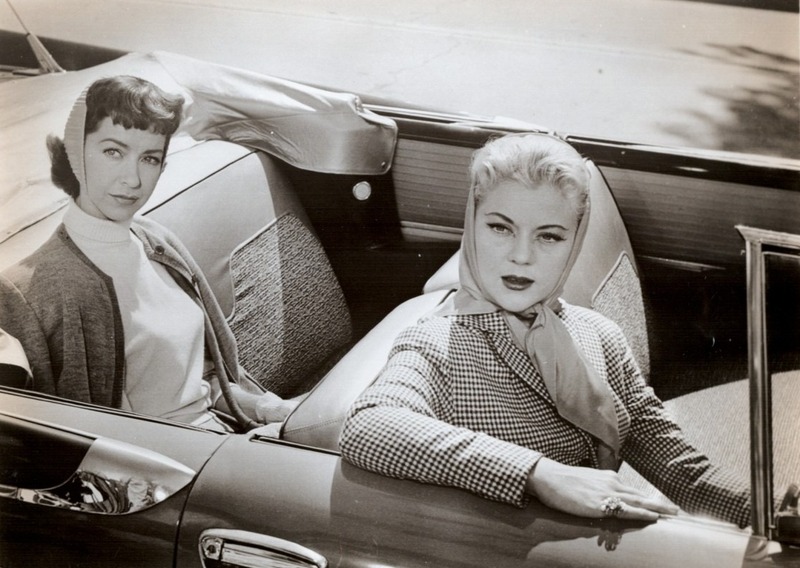
Atmospheric Gothic Chiller
MOVIE REVIEW
Back from the Dead
Approved –
Genre: Horror
Year Released: 1957, 2024 Kino Lorber Blu-ray
Runtime: 1h 19m
Director(s): Charles Marquis Warren
Writer(s): Catherine Turney
Cast: Peggie Castle, Marsha Hunt, Arthur Franz, Don Haggerty, Helen Wallace, Otto Reichow, James Bell, Marianne Stewart, Evelyn Scott, Ned Glass
Where To Watch: available May 21, 2024; pre-order here www.kinolorber.com or www.amazon.com
RAVING REVIEW: BACK FROM THE DEAD is an atmospheric horror film from 1957 that explores supernatural possession and sinister cults. Charles Marquis Warren directs and offers a blend of eerie visuals and an intriguing narrative, albeit with some notable flaws and just playing it too safely.
BACK FROM THE DEAD follows Mandy Hazelton Anthony, played by Peggie Castle, who experiences a dramatic change after a severe seizure. Mandy sees a complete change in her being and, in doing so, learns more about her husband, Dick’s first wife, Felicia, leading to a series of disturbing events. Arthur Franz portrays the bewildered husband, and Marsha Hunt plays Mandy’s concerned sister, Kate Hazelton. The film, based on Catherine Turney's novel "The Other One," explores themes of supernatural terror and Satanic cults, which were innovative for its time. If only the film could have followed along as closely as the book.
Ernest Haller’s cinematography is a standout element, imbuing the coastal setting with a haunting atmosphere through striking black-and-white visuals. This visual style enhances the film's supernatural elements and sets the mood for the unsettling story. However, Warren's direction sometimes feels out of place in the horror genre, as he was more familiar with made-for-TV projects. His handling of the material lacks the finesse needed to transform the film from a routine thriller into a genuinely chilling experience. It often felt more like an episode of DARK SHADOWS than the dark horror it could have been.
Peggie Castle’s performance is particularly noteworthy. She portrays different depths of characters with fantastic precision, adding a layer of complexity to her character. This duality provides some of the film’s most engaging moments. The supporting cast, including Hunt and Franz, deliver solid performances despite some of the script’s limitations. Otto Reichow’s portrayal of the cult leader, Maitre Renault, adds intrigue, though his character occasionally veers into caricature and is too limited to offer the insight needed.
The narrative focuses on possession and the influence of a devil-worshipping cult. While these themes are compelling, they never felt fully developed, leaving the story incomplete. Concepts such as human sacrifice and exorcism are introduced but not explored to their potential. The climactic confrontation involving a ritualistic scene feels rushed and lacks the necessary buildup to create a significant impact.
Despite its shortcomings, BACK FROM THE DEAD offers some genuinely unsettling scenes. Mandy's transformation and the macabre incidents surrounding her character are particularly chilling for the time. The film’s unique use of music, especially the theremin score by Raoul Kraushaar, amplifies the sense of unease. This unconventional choice of instrumentation underscores the story’s supernatural aspects, making it one of the more memorable elements of the film.
BACK FROM THE DEAD had the potential to be a standout entry in the horror genre. However, its uneven execution and reliance on melodramatic tropes hinder its effectiveness. Castle’s performance and Haller’s cinematography are notable strengths that keep the film engaging. Although it may not achieve the same acclaim as later classics in the possession and cult sub-genres, it remains an interesting piece from the 1950s that offers insight into the period’s approach to supernatural storytelling.
Overall, BACK FROM THE DEAD is a curious artifact that reflects the era’s filmmaking techniques and narrative styles. Despite its flaws, it offers enough intrigue through its performances and visual elements to capture the audience’s attention. While it may not reach the heights of a horror masterpiece, it is a testament to the period's experimental approach to blending darker elements with psychological drama.
Product Extras:
NEW Audio Commentary by Film Historians Tom Weaver, Gary D. Rhodes, and Larry Blamire
NEW Audio Commentary by Film Historians David Del Valle and Dana M. Reemes
Optional English Subtitles
For more reviews, please visit https://linktr.ee/overlyhonestmr.
You can follow me on Letterboxd, Instagram, Twitter, and YouTube. You can also find my social media accounts on most platforms by searching Overly Honest Movie Reviews.
I’m always happy to hear from my readers; please say hi or send me any questions about movies.
[photo courtesy of KINO LORBER]
DISCLAIMER:
At Overly Honest Movie Reviews, we value honesty and transparency. Occasionally, we receive free items for review, including DVDs, Blu-rays, CDs, Vinyl, Books, etc. We assure you that these arrangements do not influence our reviews, as we are committed to providing unbiased and sincere evaluations. We aim to help you make informed entertainment choices, regardless of our relationship with distributors or producers.
Amazon Affiliate Links:
Additionally, this site contains Amazon affiliate links. If you purchase through these links, we may receive a commission. This affiliate arrangement does not affect our commitment to honest reviews and helps support our site. We appreciate your trust and support in navigating these links.



Average Rating